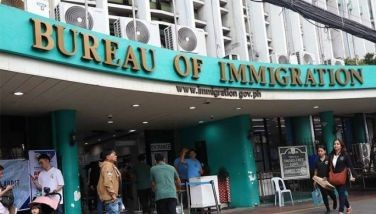Cure-all

This year there was no embarrassing New Year’s Day blackout at the Ninoy Aquino International Airport.
Instead there was a day-after-New Year massive power outage that rolled across Western Visayas beginning Jan. 2, with power still not completely restored as of yesterday.
Office work and classes were suspended, and emergency power had to be rushed to hospitals as the outages hit Panay Island, where bustling Iloilo City is located, and spread to parts of Negros and Guimaras. By 2:19 p.m. on Tuesday, Panay was isolated from the rest of the Visayas.
Yesterday, the Iloilo City government estimated its daily economic losses at up to P500 million due to the power outage. Classes in many schools remained suspended.
The National Grid Corp. of the Philippines (NGCP) pointed to the tripping of three of the largest power generating units in Panay, and the unscheduled maintenance shutdown of a 150-megawatt power generating unit.
By evening of Jan. 2, only four of 13 power plants were producing just 6.2 percent of the normal electricity demand in Panay, the NGCP reported.
The grid operator reiterated its call for a “whole-of-industry” approach to the problem. It stressed that it transmits but does not generate electricity. Factors it had raised in a letter to the city government of Iloilo in May last year remain in place and contributed to the latest power outage, the NGCP said.
* * *
Extensive outages also in Panay, Guimaras and Negros on Feb. 20 and then on April 27 last year prompted a congressional investigation of the NGCP’s performance since it took over operation of the national grid from state-run National Transmission Corp. in 2009 through Republic Act 9511. That congressional probe has not yet officially wrapped up, so it may be revived.
Many of the issues raised in the previous probe may be resurrected. Among these are suspicions of sabotage by the Chinese government, which owns the State Grid Corp. of China – the technical partner of the NGCP, with a 40 percent stake.
The State Grid Corp. obtained that stake through four rounds of open bidding in which other foreign companies participated, the NGCP previously said. The winning bid was cleared with the government and Congress granted the franchise, the NGCP pointed out.
Last year, NGCP officials had said the company is “100 percent Filipino, from top to bottom,” with Filipinos having day-to-day control over NGCP operations.
Considering developments since that congressional probe, however, suspicions of economic sabotage by a foreign government using the power grid are likely to have intensified. So the NGCP can expect questions about Chinese stake in the company to be raised again.
* * *
What members of the House of Representatives should ask is whether Charter change will cure the problems plaguing the operation of the national power grid.
Congressmen are packaging Charter change as the silver bullet for economic progress and attracting investments.
Unreliable, expensive power supply is in fact one of the top problems consistently cited by the business community in assessing prospects for investing in the Philippines.
The NGCP itself has narrated the difficulty of doing business in the Philippines, such as the mountain of red tape in its efforts to upgrade its facilities and grid capacities.
Another problem raised by investors is the failure to enforce contracts. Political pressure may yet force NGCP to replace the State Grid Corp. of China as its technical partner.
This may be good in the context of tensions in the West Philippine Sea and increasing moves in other countries to exclude Chinese companies from economic activities with national security implications. But it may also reinforce the perception in investment circles that business contracts in the Philippines are worth less than the lowest quality toilet paper.
Another concern of investors is unpredictable, politicized regulation. This is a problem raised by players in the energy sector – and many other industries for that matter.
* * *
There’s a long list of other factors, cited for many years now by foreign chambers and major local business groups, which have made the country lose its competitive edge in attracting investments.
There’s no cure-all for these problems. Many require sweeping reforms in all three branches of government, a dramatic improvement in the quality of education and consequently a better understanding of where our taxes go, along with a sea change in the way Filipinos regard public service.
Yet the House proponents of Cha-cha are presenting it as such a cure-all.
While constitutional restrictions on foreign ownership are among the disincentives to foreign investment, these are already being remedied through legislation. As for land ownership restrictions, such rules have not kept communist China and Vietnam from being among the top investment destinations in Asia.
I wouldn’t mind seeing political provisions amended along with the economic. The party-list system, for example, is a failed experiment in marginal representation and should be abolished.
The Constitution that was ratified in 1987 had an overarching consideration: to prevent a return of authoritarian rule and the perpetuation of any official in power.
Politicians found a way to go around this, by refusing to carry out the constitutional mandate to pass an enabling law against dynasties.
Rodrigo Duterte formed a consultative committee to draft a new Constitution that would shift the country to a federal system of government. The committee included in its draft a provision limiting but not completely banning dynasties.
The draft must have gone directly to the House garbage bin. The chamber, under Gloria Macapagal-Arroyo, promptly drew up its own proposed Charter, with no mention of any restrictions on dynasty building. And that was the end of that Cha-cha effort.
This year, with so many serious problems faced by the nation, the House will soon get busy with the cure-all, which is expected to include the lifting of lawmakers’ term limits.
Meanwhile, in the case of the Panay blackout, the NGCP is recommending a review of the Philippine Grid Code of 2001 “to cater to renewable energy sources, particularly the effective use of emerging technologies like energy storage systems.”
Like many other measures that can make the country more investment-friendly, amending the Grid Code doesn’t require Cha-cha.
- Latest
- Trending


























